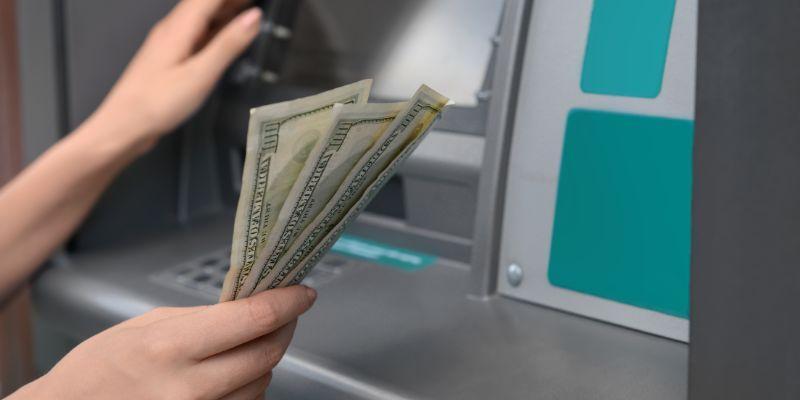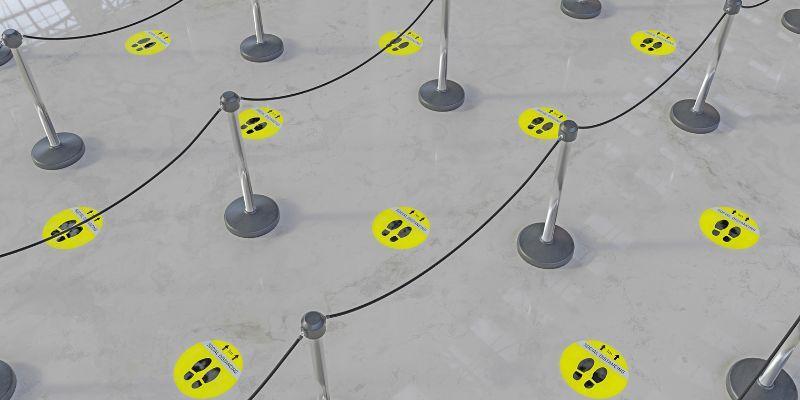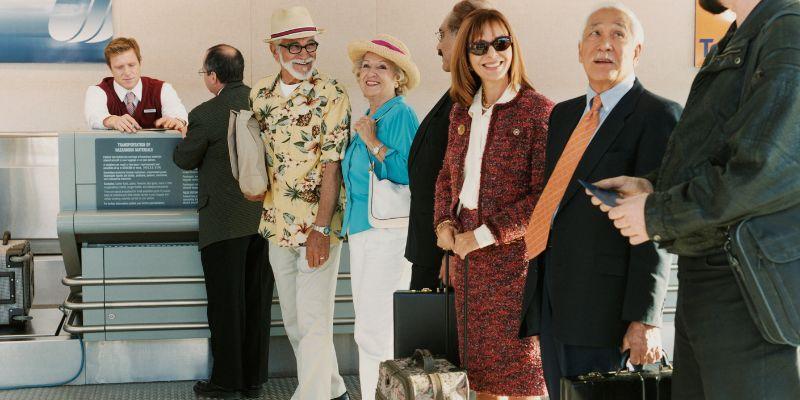In today’s fast-paced, customer-centered world, businesses increasingly adopt virtual queuing to improve service delivery and manage long wait times.
Yet, despite its growing use, many myths about virtual queuing persist, creating doubts about its effectiveness and leading some to avoid implementing it altogether.
These misconceptions can hinder businesses from adopting or optimizing virtual queuing systems, resulting in missed opportunities for better service, smoother operations, and increased customer satisfaction.
Comprehending and debunking these myths is essential to unlocking virtual queuing’s full potential.
From increasing convenience to improving overall efficiency, virtual queue systems are becoming integral to many industries, including retail, healthcare, entertainment, and hospitality.
Here, we’ll explore common myths, debunk the misconceptions, and uncover why virtual queuing is valuable in modern queue management.
Common Myths about Virtual Queuing
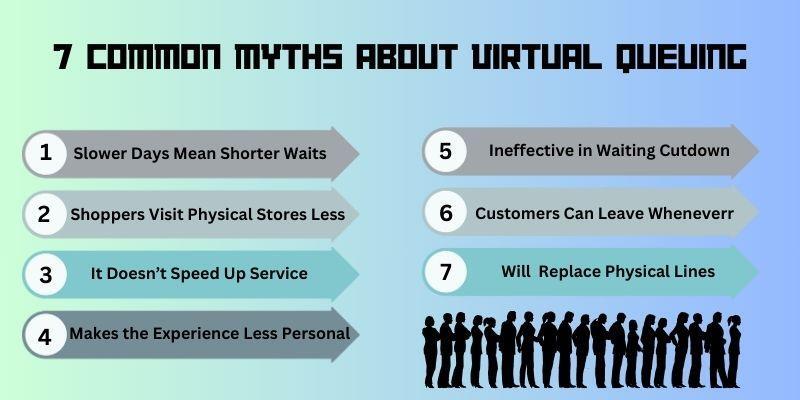
Let’s explore some common myths about virtual queuing and see how these systems work to make customer experiences smoother and business operations more efficient.
Myth No. 1: Slower Days Mean Shorter Waits
It’s a common belief that fewer people in a store or venue automatically means shorter waits. While this seems logical, the reality is more complex.
Virtual queuing misconceptions like this ignore customer flow’s unpredictable nature, which can vary greatly even on quieter days.
Variables like peak times, service speed, and specific customer needs can still lead to unexpected bottlenecks, even on a “slow” day.
For instance, consider a theme park on a rainy weekday. Though fewer visitors might be expected, certain attractions or rides may still face long lines because of the demand for higher indoor or covered attractions.
Here, a virtual queue system becomes essential in managing the flow and keeping guests updated on wait times. This helps manage customer expectations, ensuring they’re less likely to get frustrated by unanticipated delays.
Likewise, in retail stores, unpredictable events—like flash sales or limited-time discounts—can unexpectedly increase customer volume, creating wait times that are just as long, if not longer, than on traditionally busy days.
Virtual queuing allows stores to respond quickly, providing customers with a structured, convenient experience regardless of the day’s anticipated traffic.
Myth No. 2: Shoppers Visit Physical Stores Less Often
Online shopping has undoubtedly transformed retail, but brick-and-mortar stores still need to gain importance.
Physical stores continue to offer experiences and services that online shopping cannot replicate, such as face-to-face customer service, immediate product availability, and the ability to try before buying.
With virtual queuing, in-store shopping is made even more appealing by allowing shoppers to skip physical lines, making the experience more convenient and likely to result in a return visit.
For example, major retailers like Apple and Walmart use virtual queue systems to manage high customer volume, especially during peak times or new product releases.
These systems allow customers to browse while waiting, enabling them to stay in the store but outside the line. This creates a more positive shopping environment and reinforces the role of physical stores, as customers feel prioritized and valued.
In fact, with virtual queuing, stores can reduce crowding and maintain a steady, manageable flow. This experience development ultimately supports the view that physical stores aren’t outdated—they’re evolving, with virtual queuing debunked to keep them relevant and convenient.
Myth No. 3: Virtual Queuing Doesn’t Help Speed Up Service
One of the primary myths about virtual queuing is that it doesn’t improve service speed, leading some to question its value.
This misconception overlooks a key benefit of virtual queuing: it enables staff to concentrate on serving customers rather than managing lines, which can significantly boost service efficiency.
With virtual queuing, employees can anticipate each customer’s needs, rationalize the interaction process, and reduce wait times.
Consider how banks use virtual queue systems to better prepare for customer inquiries or transactions. With virtual queuing, bank staff can access customer details in advance, anticipate needs, and speed up service delivery.
This is especially beneficial during peak hours when the ability to serve customers quickly can drastically improve satisfaction.
Another great example is in healthcare settings, where virtual queuing simplifies patient intake and reduces appointment wait times.
When reducing congestion in waiting rooms, healthcare providers can ensure smoother transitions between patients, making it clear that virtual queuing debunked this myth and can genuinely increase efficiency.
Myth No. 4: Virtual Queuing Makes the Customer Experience Less Personal
A common misconception about virtual queuing is that it makes the customer experience impersonal.
In truth, virtual queuing can lead to a more personalized experience by utilizing digital tools that keep customers informed and engaged throughout their wait.
For example, businesses can send timely updates, reminders, and personalized messages, showing customers they are valued and their time is respected.
Retailers also use virtual queuing to improve customer communication, sending updates about queue status or special offers that improve the waiting experience.
Far from being impersonal, virtual queuing debunked the notion that it is disconnected, revealing its ability to make personalized interactions.
Myth No. 5: If Virtual Queuing Doesn’t Cut Down on Wait Times, It’s Ineffective
One significant myth about virtual queuing is that it serves no purpose if it doesn’t reduce actual wait times. However, what matters most to customers is the perceived wait experience, not necessarily the wait length itself.
Virtual queue systems allow customers to use their wait time productively, improving their experience even if the wait remains the same.
For example, virtual queuing in amusement parks like Disney World lets visitors explore other attractions, eat, or shop instead of standing in line.
When allowing customers to utilize their wait time differently, virtual queuing transforms what could be a stressful experience into an enjoyable one.
In restaurants, virtual queuing debunked the idea that it’s only valid if it cuts wait times. Many dining establishments let customers join virtual queues and receive updates so they can relax in a nearby area, grab a coffee, or chat with friends while they wait.
Myth No. 6: Customers Can Leave When They Want
Another virtual queuing misconception is that customers can simply exit the queue whenever they please without consequence. In reality, customer abandonment rates are influenced by actual wait times rather than the option to leave.
Businesses that keep customers informed and engaged during their wait experience reduced abandonment rates, showing how effective virtual queuing can be with the right approach.
For instance, retail stores or restaurants often send reminders to customers when they’re nearing the front of the line. This proactive communication reassures customers about their position in the queue, making them less likely to leave.
When managed well, virtual queuing debunked the notion that customer abandonment is an issue by showing how engagement can significantly reduce it.
Myth No. 7: Virtual Queuing Will Completely Replace Physical Lines
Many believe virtual queuing will eliminate physical lines, but this isn’t always true. Certain situations, like emergency services or large-scale events, still require physical lines.
Hybrid queuing systems combine virtual and physical elements and offer a practical solution for such contexts, providing flexibility to cater to different needs.
Consider a hospital setting where a hybrid system can handle online check-ins and in-person line-ups to manage patient flow. This dual approach allows for better crowd control while maintaining accessibility, proving that virtual queuing can complement rather than replace physical queues entirely.
The Importance of Addressing These Myths

Why is debunking virtual queuing challenges essential for businesses considering virtual queuing systems?
Businesses must address virtual queue system myths to reap the benefits of virtual queuing fully.
These myths can create misconceptions about effectiveness, discouraging decision-makers from implementing or optimizing virtual queuing solutions.
Believing in these myths limits businesses from improving the efficiency and satisfaction levels that virtual queuing systems can offer.
Understanding the reality behind these myths can help businesses unlock opportunities to improve customer flow, reduce perceived wait times, and align operations.
Additionally, correcting these misconceptions can help businesses stay competitive. Customers increasingly expect efficient, user-friendly solutions, and a well-implemented virtual queuing system not only meets this demand but can also drive higher customer retention and loyalty.
Businesses that successfully implement virtual queuing benefit from smoother operations and a more satisfied customer base, reinforcing brand loyalty and enhancing their reputation for reliability and convenience.
Explore our virtual queuing solution to learn how addressing these myths can benefit your business.
How to Make the Most of Virtual Queuing?
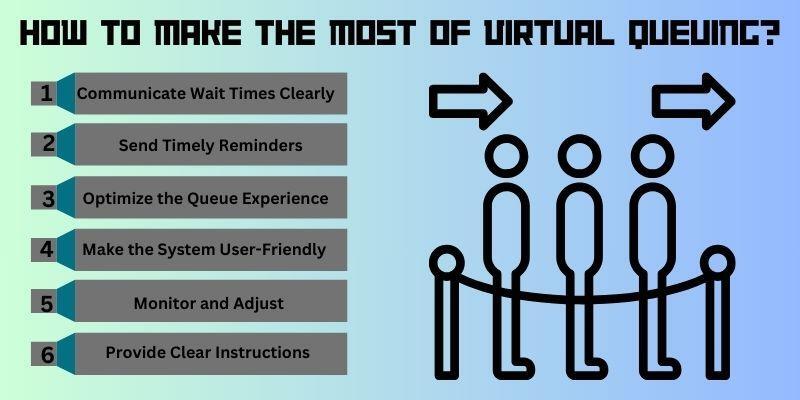
Optimizing virtual queuing systems can significantly boost customer satisfaction and build loyalty. Here are some key strategies to help businesses make the most out of their virtual queue systems, focusing on clear communication, ease of use, and adaptability.
1. Communicate Wait Times Clearly
Precise, real-time updates about wait times are essential for building customer trust. Transparency helps set realistic expectations, reducing the anxiety and frustration often associated with waiting.
With accurate information, customers feel more in control and are more likely to view the waiting experience positively. For instance, airlines and theme parks commonly use virtual queue systems to display estimated wait times, allowing customers to plan their time more effectively.
Regular wait-time updates throughout the queue journey can reassure customers and keep them informed. This also allows them to enjoy other activities, improving overall experience and satisfaction.
2. Send Timely Reminders
Sending reminders at appropriate intervals keeps customers engaged and reduces the risk of abandonment. A good practice is to notify customers when they’re nearing their turn or if they need to stay within a specific proximity.
For example, a restaurant might send reminders when a customer is five or ten minutes away from being seated, ensuring they’re close by and ready. These timely notifications are beneficial for virtual queuing in retail, healthcare, or hospitality settings, where minimizing no-shows is crucial.
Businesses can also use reminder notifications to share relevant information, such as special offers or available services, adding value to the customer experience.
3. Optimize the Queue Experience
Making the queue experience enjoyable helps reduce frustration. Businesses can add value to the wait by offering perks, like discounts, refreshments, or entertainment for longer wait times. This approach, often seen in hospitality and retail, can make customers feel appreciated and valued.
Theme parks, for example, sometimes offer visitors access to additional attractions or virtual games while they wait in line.
Offering incentives doesn’t have to be costly; even simple perks like access to exclusive content or small discounts can make the virtual queue system experience positive and memorable.
4. Make the System User-Friendly
A user-friendly interface is essential for minimizing friction in a virtual queuing system. Customers expect a smooth, intuitive experience that requires little effort to navigate.
Prioritizing clear instructions, intuitive design, and a responsive system ensure that customers have no difficulty joining or managing their spots in the queue.
Simplified navigation is vital, especially for first-time users or those less familiar with digital systems. Providing a smooth experience is crucial in boosting customer satisfaction and retention.
5. Monitor and Adjust
Regularly monitoring the virtual queue system and analyzing data allows businesses to make necessary adjustments in real-time.
Understanding peak times, common bottlenecks, and abandonment patterns can help businesses optimize the queuing experience and better meet customer needs. Data analysis can guide improvements, help adjust wait times, increase reminders, or offer additional support when needed.
For example, by observing queue patterns in a theme park, managers can predict high-demand times and prepare accordingly, which improves overall efficiency and customer experience.
6. Provide Clear Instructions
Clear instructions are vital in any virtual queue system. Customers need to understand how to join, check their place in line, and know when their turn is approaching. Clear, step-by-step guidance minimizes confusion and frustration, creating a smoother and more enjoyable customer experience.
In environments like healthcare, where patients may feel stressed, concise instructions provide peace of mind, helping them know exactly what to expect and when.
Conclusion
In summary, dispelling myths about virtual queuing is vital for businesses aiming to elevate service delivery and customer satisfaction.
Adopting virtual queuing while addressing these misconceptions can improve customer and staff experiences and develop smoother, more efficient operations.
With a well-optimized virtual queuing system, businesses can create a more convenient, customer-centered environment that increases satisfaction and drives loyalty.
BOOK A FREE DEMO

